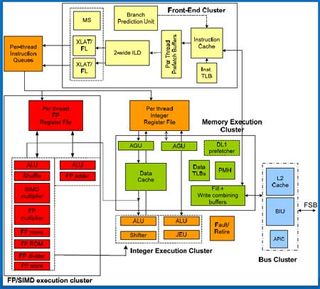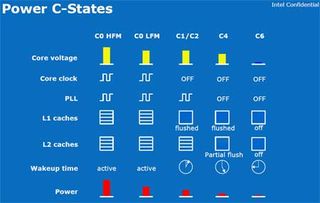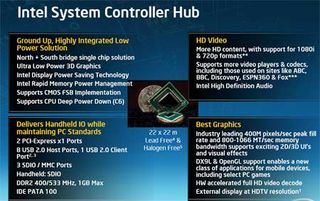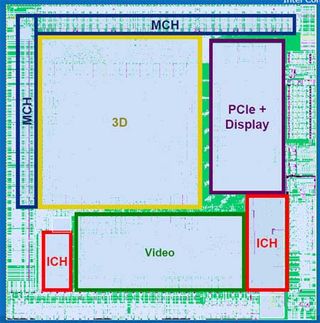Intel Fires Up New Atom Processors
Intel Fires Up New Atom Processors
We were not able to get more details how far Silverthorne will scale in the end. Intel said that the CPU is expected to stay with us for at least five to six years, supported by several fine-tunings over time. When asked directly what clock speed the processor will actually be able to handle, we were simply told that the "silicon is capable of high frequencies."
We leave it up to overclockers to determine what this exactly means, but there appears to be lots of headroom for Silverthorne. We saw a non-cooled CPU running in Intel's labs at 1.2 GHz with a 100% application load, showing a temperature of 43 degrees Celsius. Admitted, this was a test environment without cases and the chip will certainly run hotter inside a MID enclosure. But we also saw the 1.2 GHz chip running without trouble at (an artificially increased) temperature of 90 degrees Celsius - which indicates that overclockers will have a lot of fun with this CPU (which, by the way, looks like a great processor for small form factor systems as well).
Power consumption as low as 80 milliwatts
Silverthorne is not a chip that aims to set new performance records, but rather to provide good-enough performance in MIDs. The focus of the development was a power-efficient design.
Aside from the plain specs, Intel loaded the processor with power reduction technologies, which ultimately achieved the 2 watt-goal (we discuss the 2.4 watt version in the software technology section below). Atom comes with dynamic L2 cache sizing, power-efficient specialized execution units and the same fine-grained power management that is used in the Core 2 Duo. There are five different power states, ranging from a reduction of the core voltage to shutting down the core clock as well PLL, L1 and L2 caches.

In idle power (C6 power state), Intel claims that the Z500 will consume just 80 milliwatts (all other versions: 100 milliwatts). Since these communication devices will remain in idle state most of the time in typical use patterns, Intel estimates that the average power consumption of these processors will end up at 160 milliwatts (Z500) or 220 milliwatts (all other models).
How much these chips will actually consume and how long your MID battery life will be, depends on how you use such a device, of course. What Intel has achieved with Menlow is impressive on the one side, but there will be many people who will argue that it has not been enough.
Stay on the Cutting Edge
Join the experts who read Tom's Hardware for the inside track on enthusiast PC tech news — and have for over 25 years. We'll send breaking news and in-depth reviews of CPUs, GPUs, AI, maker hardware and more straight to your inbox.
In a lab environment, we saw Silverthorne running the Windows Pinball game in idle (C6) mode - which means that playing this simple game will still yield low power consumption. But we are certain that battery time will be one of the major roadblocks for MIDs. If you think about the fact that first-generation MIDs will come with a battery capacity similar to that of the iPhone, but a 5" screen and more powerful hardware, it is only logical to conclude that the battery time of these devices will be less impressive. Officially, we were told that these MIDs will not be able to achieve the battery time of an iPhone: If you can empty an iPhone in three hours under heavy use, you may be able to do the same with an MID in two.
Intel promises that the battery time will improve in product generations, which includes the second-gen platform "Moorestown" which, by the way, will also target smartphones.
Integrated Graphics Chipset: A big System Controller Hub
Combined with the Poulsbo chipset, Atom represents the "Menlow" platform, which succeeds the "McCaslin" UMPC platform that was based on the A100/A110 processors.
Poulsbo has received the strange name of "SCH" and has its origins in the 915 (including the ICH M7 southbridge) chipset. This chipset was has been heavily discussed in the Windows Vista Capable Class action lawsuit, as it is considered the reason why Microsoft released "Ready" and "Capable" versions of the Windows Vista operating system. It was not an especially powerful technology at the time and certainly underpowered to run all features of Windows Vista.

The specs of SCH include a maximum display resolution of 1366x768 (LVDS), hardware accelerated video output (standard definition video output of 1280x1024 and high definition video output of 720p, 1080i), eight USB 2.0 ports, support for up to 2 GB DDR2-533 memory, SD IO v1.1 (for SD memory card support), two PCIe X1 ports, as well as an IDE ATA-100 (PATA) connector.
It is a very traditional chipset design overall, but Poulsbo has a big focus on power consumption as well and some unique features in this respect: There is a newly designed FSB-to-memory bridge, which reduces the write traffic to DRAMs in order to keep DRAMs in self-refresh mode as long as possible. Intel's engineers were able to re-use about half of the ICH 7 M southbridge fabric (to provide BIOS consistency). In this version, it runs at only 33 MHz, while the regular ICH 7 M is clocked at 125 MHz. In case you are wondering, the ICH southbridge is maxed out at a front side bus speed of 533 MHz.

There are a few other interesting facts about this chipset.
First, we were surprised to hear that it is actually produced in a 130 nm production process, which is three generations behind the 45 nm process used for Atom. Intel said that it is actually cheaper for the company to manufacture it in 130 nm than in any other process that was available, but the downside is that the chipset is large in size (22 mm x 22 mm package). While the Atom processor is about the size of a penny, the SCH is larger than a quarter. The SCH's substantial size is one of the main reasons why Atom isn't targeting smartphones at this time - it is simply too large for an iPhone-like device.

Also, mass storage is supported only through a PATA interface. This decision was made as Intel did not know whether SATA or CE-ATA would prevail in this class of devices at the time this chipset was developed. So don't expect SATA SSDs in MIDs - which may actually not be a bad thing, as PATA SSDs are not only cheaper, but also consume less power than versions that connect through SATA.
Read on the next page: Atom Software: Betting on Linux and dumping Windows, Performance estimates
Current page: Intel Fires Up New Atom Processors
Prev Page Intel Fires Up New Atom Processors Next Page Intel Fires Up New Atom ProcessorsMost Popular

